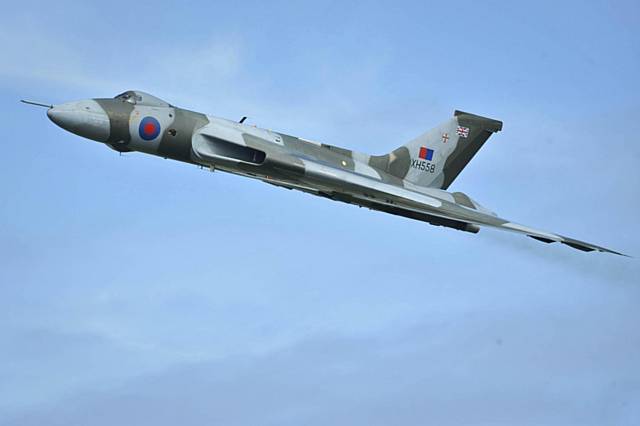Hero of Cold War finally honoured
Date published: 31 October 2011

Photo: PRESS ASSOCIATION Photo
The only airworthy example in the world of the Avro Vulcan bomber.
A Cold-War bomber built in Chadderton has been honoured as one of the UK’s top engineering achievements.
The last remaining airworthy Vulcan has received an Engineering Heritage Award — which has previously been bestowed on the likes of Tower Bridge and the Channel Tunnel.
Avro’s chief designer Roy Chadwick, who is honoured with a heritage Blue Plaque in Chadderton, first sketched out the design for the Vulcan in 1946. That was just five years after the first flight of his famous Lancaster Bomber. He died in a plane crash a year later and never saw his masterpiece fly.
In its Cold-War heyday, the Vulcan was on 24-hour stand-by to drop nuclear bombs on the Soviet Union, although no British bomber ever flew with a live nuclear weapon.
During the Falklands War, five Vulcans took part in record-breaking 8,000-mile flights from Ascension Island to bomb the runway at Port Stanley. The Vulcan XH558 was built at the former Avro factory in Chadderton, later BAE Systems, in 1960 and was part of the RAF’s Cold-War strategic bomber fleet.
It was the twelfth Vulcan B2 to be manufactured and served in reconnaissance and air-to-air refuelling roles until 1985.
Although most Vulcans were retired by the mid-1980s, the XH558 carried on with airshow duties until 1992 when budget cuts forced its retirement.
It was restored after a multi-million fund-raising campaign by the Vulcan to The Sky Trust and took to the skies again in 2007.
The XH558 will mark the Queen’s Diamond Jubilee next year with a fly past over The Mall on June 4.
Prof Isobel Pollock, president-elect of the Institution of Mechanical Engineers which gave the award, said: “It is testament not just to the extraordinary engineering involved in making the Avro Vulcan, but also to the fantastic work the Vulcan in the Sky Trust does to maintain the aeroplane.
“Preserving and celebrating great works of engineering is exactly what the Engineering Heritage Awards are about, and the fact the Vulcan is in good enough condition to take part in 30 displays next year honouring the Queen’s Diamond Jubilee — as well as its own — is certainly worth celebrating.”
Most Viewed News Stories
- 1A new neighbourhood on the way for Oldham?
- 2‘New’ town hall due to open to public for first time after full cost of major refurb project...
- 3Crompton House students excel again on A Level results day
- 4Part of iconic Chadderton mill complex to be transformed into warehouses
- 5Blue Coat Head's delight on another memorable A Level results day




